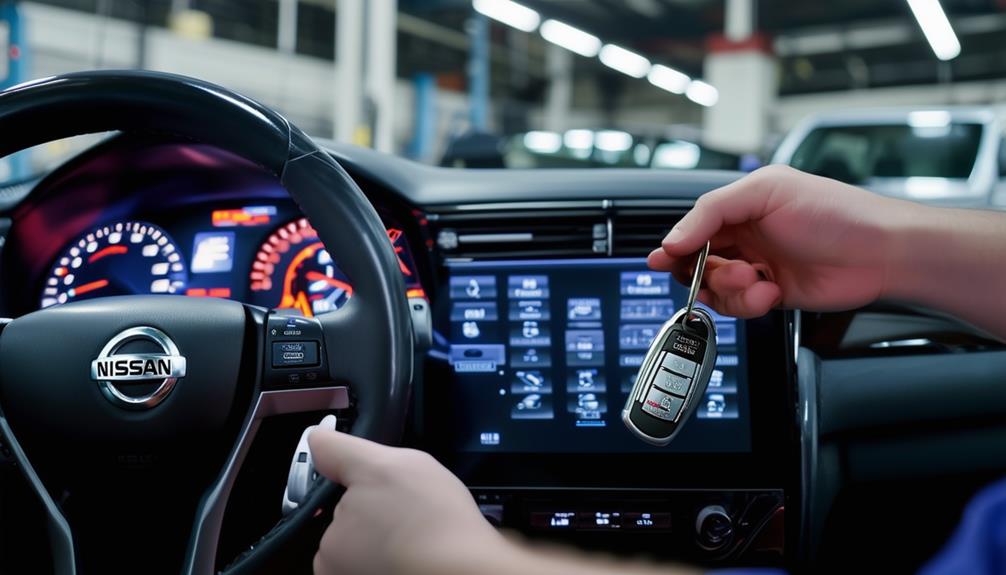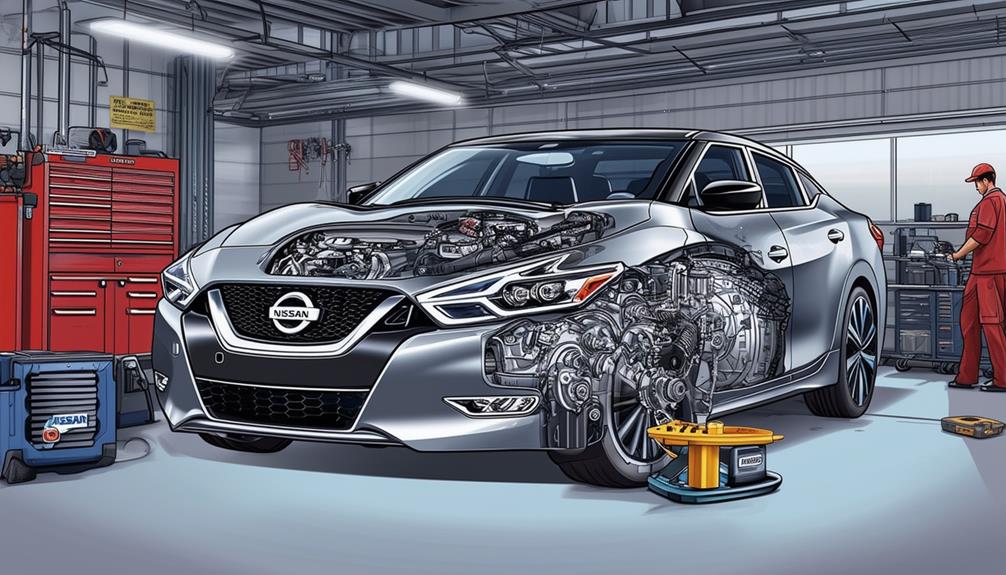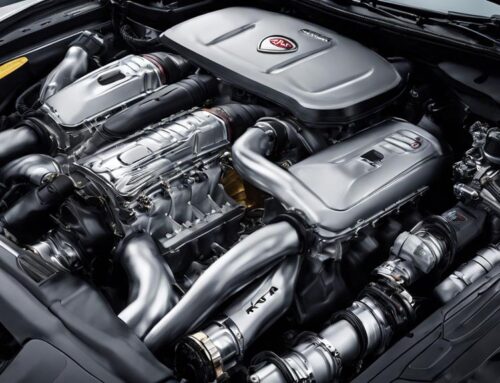You're likely facing common issues with your Nissan Maxima like engine overheating from cooling system malfunctions, thermostat failures, or oil leaks. Electrical problems might stem from blown fuses or wiring malfunctions affecting dashboard lights and power windows. For brake and suspension concerns, watch for worn brake pads, warped rotors, and damaged struts. Transmission troubles often include fluid leaks and gear shifting issues. Battery drain is typically due to alternator problems or parasitic drain. Audio and infotainment glitches can often be resolved by updating firmware or re-pairing Bluetooth connections. Continue reading to gain a deeper understanding and find solutions.
Key Takeaways
- Check for overheating due to cooling system malfunctions, such as a stuck thermostat or oil leaks.
- Inspect for electrical problems including wiring issues, blown fuses, and flickering dashboard lights.
- Diagnose brake issues like worn pads, warped rotors, and sticking calipers causing uneven wear.
- Address transmission problems by checking fluid leaks, gear shifting issues, and performing sensor diagnostics.
- Use an OBD-II scanner to identify and resolve common fault codes like P0420, P0500, and P0300.
Common Engine Problems

Dealing with common engine problems in your Nissan Maxima can be frustrating, but understanding these issues is essential for timely maintenance. One prevalent issue you might encounter is overheating. Overheating issues typically stem from a malfunctioning cooling system. Check your coolant levels regularly, and inspect for any leaks in the radiator or hoses. A thermostat stuck in the closed position can also prevent coolant flow, causing your engine to overheat.
It's also wise to be aware of the electrical system components that interact with the cooling system, as faults here can exacerbate overheating problems.
Oil leaks are another common problem. These can originate from various places, such as the valve cover gasket or the oil pan. Regularly inspect these areas for signs of oil seepage. Additionally, a drop in oil levels can lead to inadequate lubrication, causing engine components to wear prematurely.
If you notice your Maxima idling roughly or experiencing a loss of power, these symptoms can indicate several potential issues. Start by examining the spark plugs; worn or fouled plugs can disrupt the combustion process, leading to rough idling. Additionally, check the fuel injectors for clogs, as this can impede fuel delivery, contributing to power loss.
Another critical component to inspect is the mass airflow sensor (MAF). A faulty MAF sensor can send incorrect air intake data to the engine control unit (ECU), resulting in suboptimal air-fuel mixtures and subsequent performance issues. Clean or replace the MAF sensor as necessary to make sure proper engine function.
Electrical Faults
While addressing engine problems, it's equally essential to pay attention to electrical faults in your Nissan Maxima. Ignoring these can lead to inconvenient breakdowns and costly repairs. Electrical systems are the vehicle's nervous system, and when they malfunction, it can affect many components. Consider the importance of regular maintenance to prevent these issues from escalating.
One of the most common issues you might encounter is wiring malfunctions. Over time, wires can become frayed, corroded, or disconnected, leading to erratic behavior in your car's electrical systems. Regular inspections can help you identify and remedy these problems early.
Fuse problems are another frequent culprit. Fuses protect your vehicle's electrical circuits, but when they blow, they can cause sudden failures in various systems. Always check your fuses first if you experience any electrical issues.
Dashboard lights can provide valuable clues about your Maxima's health. If these lights flicker or fail to illuminate, it could indicate a deeper electrical issue. Confirm all dashboard indicators are functioning properly to avoid surprises.
Power window failures aren't just inconvenient; they can also signify broader electrical issues. If your windows are slow to respond or don't work at all, it could be a symptom of a failing motor or a bigger electrical fault.
To stay ahead of these issues, keep an eye on the following:
- Regularly inspect wiring for damage
- Check and replace blown fuses immediately
- Monitor dashboard lights for irregularities
- Test power windows frequently to guarantee functionality
- Schedule periodic electrical system diagnostics
Key System Troubleshooting

When troubleshooting the key system in your Nissan Maxima, you'll want to focus on the key fob and ignition switch, as these are frequently the root causes of related issues. Begin by examining the key fob. If it's not working, the battery might be dead. Replace the battery and test it again. If the problem persists, you might need to reprogram the key fob. Follow the manufacturer's instructions for key fob programming, ensuring you complete each step precisely to avoid errors.
Next, inspect the ignition switch. If you're experiencing starting issues, the ignition switch could be faulty. Start by checking if the dashboard lights turn on when you insert the key. If they don't, the issue could be with the ignition switch itself. Examine the connections and wiring for any signs of wear or damage. A multimeter can be used to test the electrical continuity of the ignition switch.
For more advanced troubleshooting, consider the car's immobilizer system. If the immobilizer isn't recognizing the key fob, it can prevent the vehicle from starting. This usually requires specialized diagnostic tools to identify and resolve the issue. Updating the software in your vehicle's control module might also help, as modern vehicles often rely on firmware updates to fix bugs and improve performance.
If you need detailed programming instructions, you can find a complete guide on mastering key fob programming for Nissan Maxima.
Brake and Suspension Issues
Brake and suspension issues in your Nissan Maxima can greatly impact both safety and performance. Addressing these problems promptly guarantees your vehicle operates smoothly and safely. Let's delve into some common concerns and their potential solutions.
Common Brake Issues
Brake noise is a frequent complaint among Nissan Maxima owners. This issue can stem from several sources, such as worn-out brake pads or damaged rotors. It's crucial to identify the root cause to maintain peak braking performance. For a more detailed insight on how to maintain your vehicle, consider reviewing an indispensable maintenance guide.
- Worn Brake Pads: When pads wear down, they can cause a squealing noise. Replacing them promptly is crucial.
- Warped Rotors: Warped rotors can produce a grinding sound and affect braking efficiency.
- Brake Caliper Problems: Sticking calipers can cause uneven brake pad wear, leading to noise and reduced braking power.
- Contaminated Brake Fluid: Old or dirty brake fluid can compromise braking efficiency. Regular fluid changes are crucial.
- Loose or Damaged Brake Components: Inspect for loose or damaged parts that could be causing noise.
Suspension Concerns
Suspension vibrations are another issue that can affect your driving experience. These vibrations can occur due to worn-out components or misalignment.
- Worn Shock Absorbers: If your shocks are worn, you'll notice increased vibrations and reduced handling.
- Damaged Struts: Damaged struts can cause vibrations and impact your Maxima's stability.
- Misaligned Wheels: Ensure your wheels are properly aligned to prevent vibrations and guarantee smooth handling.
- Worn Suspension Bushings: Over time, bushings can degrade, leading to increased noise and vibrations.
- Tire Issues: Inspect your tires for uneven wear or damage, which can contribute to suspension vibrations.
Transmission Troubleshooting

Addressing brake and suspension issues ensures your Nissan Maxima stays safe and operates at its best, but it's equally essential to pay attention to the transmission. Transmission troubles can result in expensive repairs and operational inefficiencies if not promptly addressed. Begin by focusing on fluid leaks troubleshooting. Transmission fluid is vital for smooth gear shifts and lubrication. If you notice red fluid under your vehicle, inspect the transmission pan, seals, and gaskets immediately.
Gear shifting problems are another common issue. Hesitation, rough shifting, or slipping can indicate worn-out components or low fluid levels. Regularly check and maintain your transmission fluid to avoid these common pitfalls.
| Problem | Action Needed |
|---|---|
| Fluid Leaks | Inspect pan, seals, and gaskets |
| Gear Shifting Problems | Check fluid levels and condition |
| Torque Converter Issues | Diagnose for overheating or wear |
| Transmission Sensor Faults | Perform a sensor diagnostic scan |
Torque converter issues can greatly impact your driving experience. Symptoms like shuddering, overheating, or a noticeable drop in fuel efficiency should not be ignored. These problems often stem from worn-out components or insufficient fluid. Address them promptly by consulting a professional mechanic.
Transmission sensor faults can disrupt the coordination between the engine and transmission, leading to erratic shifting and poor performance. Diagnostic scans using advanced tools can pinpoint faulty sensors, allowing for precise repairs.
Identifying Security System Glitches
Security system issues in your Nissan Maxima can be frustrating and potentially leave your vehicle exposed. Identifying these problems early is vital to maintaining your car's security and functionality. Let's delve into the most common issues you might encounter and how to identify them.
Alarm malfunctions can be particularly bothersome, appearing as false alarms or a complete failure to activate. These issues often arise from faulty sensors or wiring issues. If your alarm goes off unexpectedly, it's likely due to a sensor that needs recalibration or replacement.
Conversely, if your alarm fails to trigger, examine the wiring for any signs of wear or damage.
Immobilizer problems can also cause significant trouble. The immobilizer is meant to prevent your Nissan Maxima from starting without the correct key, but it can occasionally malfunction. Signs of immobilizer issues include the engine not starting and the security indicator light remaining on. These problems could stem from a malfunctioning key fob or an issue with the immobilizer control module. It should be emphasized that key fobs, especially those with transponders or smart keys, can be responsive to battery levels and signal interference.
Here are some steps to help you identify and resolve these security system issues:
- Check for error codes: Utilize an OBD-II scanner to retrieve any error codes associated with the security system.
- Inspect key fobs: Confirm that your key fob's battery isn't drained and the device is operating properly.
- Test sensors: Validate the functionality of all alarm sensors by performing a system test.
- Examine wiring: Look for any compromised or corroded wires that may impact system performance.
- Refer to the manual: Consult your Nissan Maxima's owner manual for specific troubleshooting procedures.
Battery Drain Issues

Battery drain problems in your Nissan Maxima can swiftly transform into a major inconvenience, leaving you stranded with a vehicle that won't start. Understanding the root causes of these problems is crucial for maintaining your car's reliability and performance. Two primary culprits are alternator problems and parasitic drain. For further information on safety and maintenance, you can refer to the Nissan Maxima Safety Recall and Maintenance Guide.
First, let's discuss alternator issues. The alternator is responsible for charging the battery while your vehicle is running. If the alternator isn't functioning properly, the battery won't receive the charge it needs, leading to a gradual drain. You might notice warning signs such as dimming headlights, a dead battery, or even the battery warning light on your dashboard. To diagnose alternator problems, measure the voltage output; it should be between 13.8 and 14.4 volts when the engine is running. Anything outside this range indicates a malfunction.
Next, consider the possibility of a parasitic drain. This happens when electrical components in your Maxima continue to draw power even when the vehicle is turned off. Common sources of parasitic drain include faulty wiring, aftermarket accessories, and malfunctioning electronic modules. To identify a parasitic drain, you'll need an ammeter. Disconnect the negative battery terminal and connect the ammeter in series. A reading above 50 milliamps typically indicates an abnormal drain. Systematically remove and replace fuses to pinpoint the faulty circuit.
Dealing with battery drain issues promptly guarantees that your Nissan Maxima remains dependable. By focusing on alternator issues and parasitic drain, you can troubleshoot effectively and implement innovative solutions to keep your vehicle running smoothly.
Audio and Infotainment Troubles
Audio and infotainment issues in your Nissan Maxima can disrupt your driving experience and make even short trips frustrating. When your vehicle's advanced systems aren't performing at their best, it can diminish the joy that comes with owning a high-tech car. Let's delve into the common problems you might encounter and the steps to troubleshoot them.
One frequent issue is Bluetooth connectivity. If your Maxima's Bluetooth isn't pairing with your devices, try these steps:
- Restart your devices: Turn off and restart both your car and smartphone.
- Delete and re-pair: Remove the car from your phone's Bluetooth list and pair again.
- Check for interference: Make sure other Bluetooth devices aren't causing interference.
- Update firmware: Ensure your device firmware is up to date. Sometimes, advanced fob components in the car may also need updating.
- Adjust settings: Verify that Bluetooth permissions are correctly set on your phone.
Touchscreen responsiveness is another area where problems can arise. If the touchscreen on your infotainment system becomes unresponsive or lags, consider these troubleshooting tips:
- Clean the screen: Wipe the touchscreen with a soft, dry cloth to remove any dirt or smudges.
- Reboot the system: Restart the infotainment system to clear any temporary glitches.
- Check settings: Make sure the display settings are properly configured.
- Inspect for damage: Examine the screen for any physical damage or cracks.
- Firmware update: Confirm the infotainment system software is up to date.
Software Update Problems

Updating the software in your Nissan Maxima can sometimes be a challenging process, but it's important for maintaining peak performance and accessing new features. However, you may encounter update failures that can be frustrating and time-consuming. These issues often stem from connectivity problems, incompatible software versions, or corrupted files. Ensuring a stable internet connection is critical for a successful update. If your Wi-Fi is unstable, consider using a wired connection or visiting a Nissan dealership for professional assistance.
Additionally, if you're experiencing keyless entry issues, you might need to reprogram your key fob, which can sometimes be affected by software updates.
Navigation glitches are another common issue following software updates. These glitches can manifest as slow map loading, incorrect route guidance, or even complete system freezes. To mitigate these problems, make sure your navigation system's database is current and matches the software version. Regularly updating your maps and performing system checks can help you avoid these performance hiccups.
If you do experience update failures, your first course of action should be to reboot the infotainment system and attempt the update again. Should the problem persist, a hard reset might be necessary, but remember to back up your data before proceeding. Additionally, check Nissan's official website for any available patches or customer service bulletins that address known update issues.
For those who desire innovation and seamless functionality, staying proactive with updates is essential. Regularly monitoring Nissan's software release notes can provide valuable insights into new features and potential bug fixes. By approaching software updates methodically, you can maintain your Nissan Maxima's cutting-edge performance and enjoy a smoother driving experience.
Recurring Fault Codes
Addressing software update issues is vital, but recurring fault codes can pose a more persistent challenge for Nissan Maxima owners. These codes can be indicative of underlying issues that, if not properly addressed, could lead to more serious problems down the line. Mastering diagnostic procedures and fault code interpretation is essential to maintaining your vehicle's best performance. Utilizing key technology can greatly aid in diagnosing and addressing these issues promptly.
When faced with recurring fault codes, you need to begin with a systematic approach. Using an OBD2 scanner, read the fault codes generated by your Maxima's onboard computer. This will help you identify the specific issues that need addressing. Fault codes aren't just random numbers; they each correspond to particular problems within your vehicle's systems.
Here are some common recurring fault codes for the Nissan Maxima and what they might indicate:
- P0420: Catalyst System Efficiency Below Threshold – often related to the catalytic converter or oxygen sensors.
- P0500: Vehicle Speed Sensor Malfunction – typically points to issues with the speed sensor or wiring.
- P0171/P0174: System Too Lean – usually indicates problems with the air-fuel mixture, possibly due to a vacuum leak or faulty fuel injectors.
- P0300: Random/Multiple Cylinder Misfire Detected – can be caused by ignition system issues, such as spark plugs or coil packs.
- P0456: Evaporative Emission Control System Leak Detected (very small leak) – often associated with the gas cap or EVAP system.
Frequently Asked Questions
How Do I Troubleshoot Unusual Noises From the Exhaust System?
To troubleshoot unusual noises from the exhaust system, first inspect for rust or holes. Check for loose connections and damaged hangers. Troubleshooting issues like interior water leaks may reveal hidden causes related to the exhaust system.
What Are Common Causes of Interior Water Leaks in a Nissan Maxima?
Your car could turn into a swimming pool if you ignore interior water leaks. Check window seals for wear and tear. Inspect the drainage system for clogs. These are common culprits that need immediate attention to prevent damage.
How Can I Fix Issues With the Sunroof Not Closing Properly?
To fix the sunroof not closing properly, first, check the sunroof alignment. If alignment isn't the issue, consider motor replacement. Guarantee precise calibration during installation to maintain innovation in your vehicle's functionality.
What Could Cause the HVAC System to Malfunction Intermittently?
You're likely facing electrical connections or sensor issues. Temperature control malfunction and compressor problems could also cause intermittent HVAC system failures. Check wiring, sensors, and the compressor to innovate a precise solution for your Maxima.
How Do I Address Problems With Uneven Tire Wear on My Nissan Maxima?
Did you know 35% of tire issues stem from improper alignment? For uneven tire wear, check your tire pressure and schedule a wheel alignment. Proper maintenance guarantees peak performance, enhancing your driving experience and vehicle longevity.
Conclusion
Handling Nissan Maxima issues can feel like sailing through a storm, but with the right troubleshooting tools, you can map a smooth course. From engine quirks to electrical faults, and key system glitches to brake concerns, addressing these problems head-on guarantees your Maxima runs efficiently. Keep an eye on software updates and recurring fault codes to prevent future headaches. Remember, maintaining your Maxima is like tending to a well-oiled machine—attention to detail keeps everything running seamlessly.









